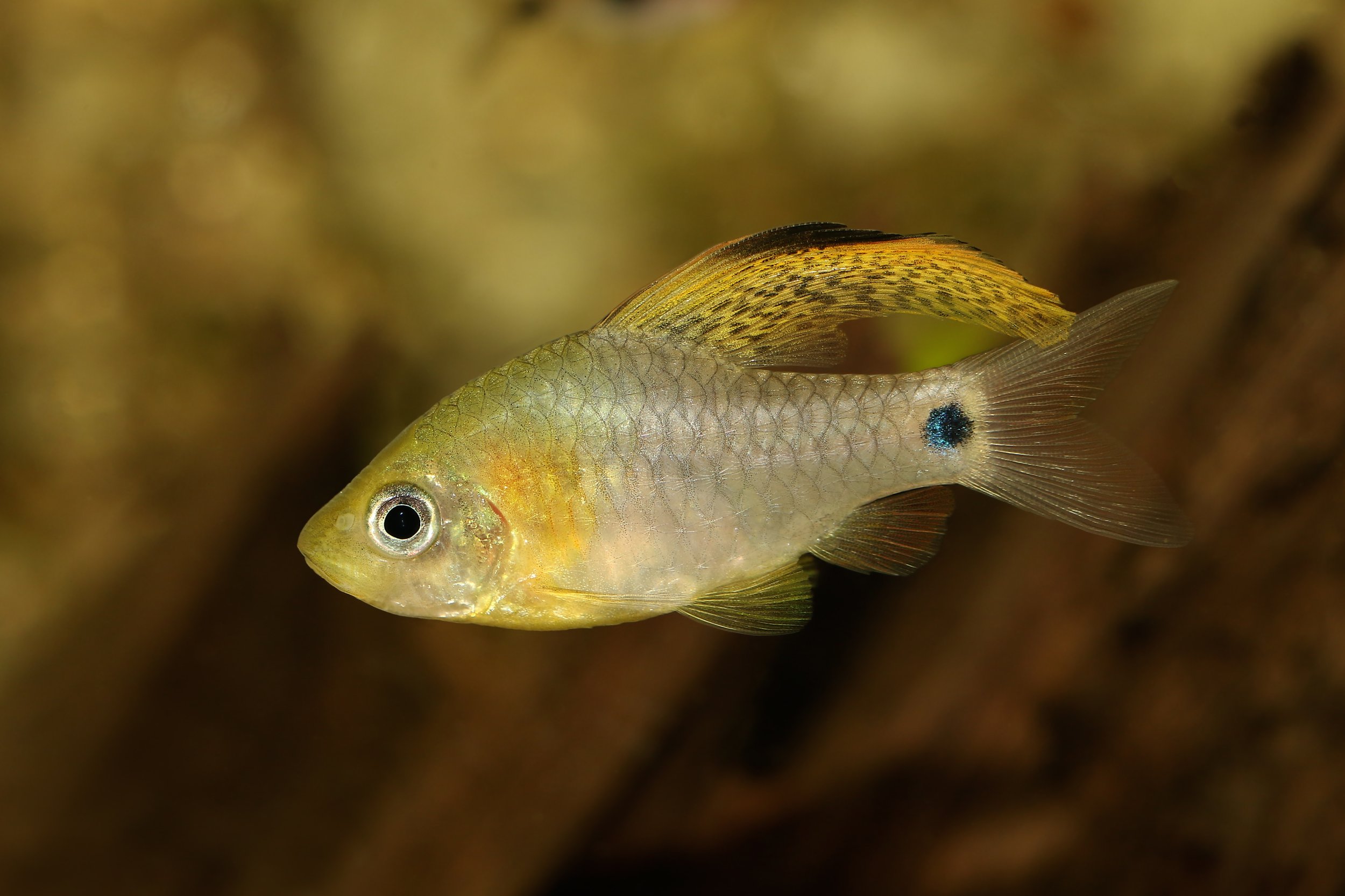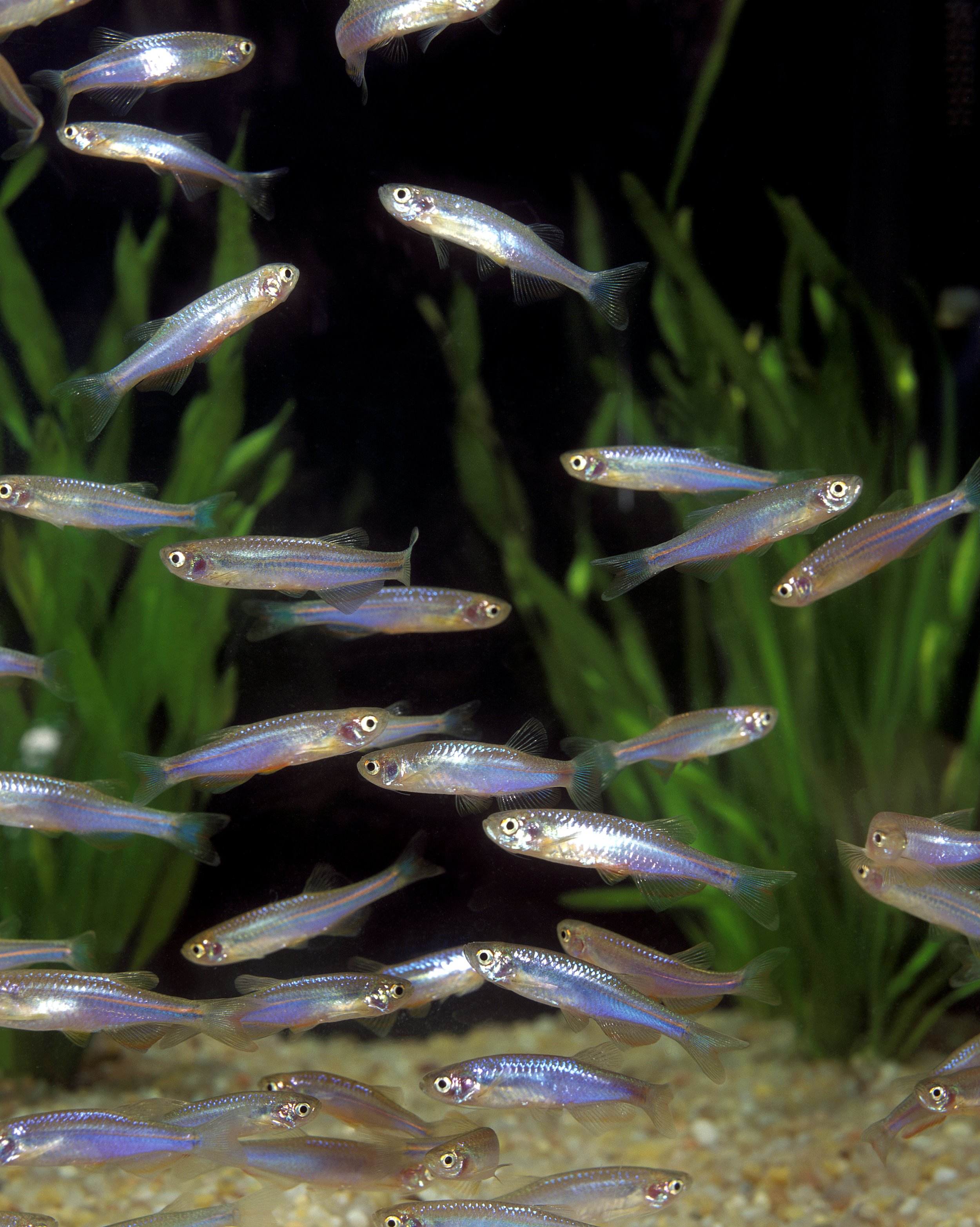 Image 1 of 3
Image 1 of 3

 Image 2 of 3
Image 2 of 3

 Image 3 of 3
Image 3 of 3




Harlequin Rasbora
The Harlequin Rasbora, scientifically known as Trigonostigma heteromorpha, is a popular and vibrant freshwater fish that has long been a favorite in the aquarium hobby. Native to Southeast Asia, particularly in regions of Thailand, Malaysia, and Singapore, the Harlequin Rasbora inhabits slow-moving waters, such as streams and peat swamps, where the water is soft, acidic, and tannin-rich. Its striking coloration, peaceful nature, and ease of care make it an excellent choice for both beginner and experienced aquarists.
Physically, the Harlequin Rasbora is easily recognizable due to its distinctive color pattern. The body is a brilliant metallic orange to copper with a characteristic black triangular patch that begins just behind the dorsal fin and extends toward the base of the tail. The contrast between the bright body and the dark patch creates a striking visual effect that stands out in a planted aquarium. Adult Harlequin Rasboras typically reach about 1.5 to 2 inches (3.5 to 5 centimeters) in length, making them suitable for a wide variety of tank sizes.
In the aquarium, Harlequin Rasboras thrive in well-planted environments with plenty of open swimming space. They are a schooling species and should be kept in groups of at least six to eight individuals, as this encourages natural schooling behavior and helps them feel secure. The more individuals in the school, the more comfortable and active they will be. A well-planted tank with floating plants, driftwood, and soft substrates mimics their natural habitat and helps create a calming environment. Harlequin Rasboras are peaceful and make excellent tank mates for other small, non-aggressive species such as tetras, Corydoras, and small gouramis.
Water parameters for the Harlequin Rasbora should resemble their native Southeast Asian waters. They prefer soft, slightly acidic water with a pH range of 6.0 to 7.5 and temperatures between 72 to 80°F (22 to 27°C). The addition of tannins, through the use of driftwood or Indian almond leaves, can help simulate the natural blackwater environment they are accustomed to. Maintaining clean, well-filtered water with regular water changes is crucial for their health and well-being.
Feeding Harlequin Rasboras is simple, as they are omnivorous and will readily accept a variety of foods. They thrive on a diet of high-quality flakes or micro-pellets, supplemented with live or frozen foods such as brine shrimp, daphnia, and bloodworms. Offering a varied diet will help maintain their health, coloration, and activity levels.
Breeding Harlequin Rasboras in captivity is possible and relatively straightforward. They are egg scatterers, meaning the female will scatter her eggs on the underside of broad leaves or similar surfaces. To encourage breeding, it is recommended to set up a separate breeding tank with soft, acidic water and plenty of plants. After spawning, the eggs hatch within 24 to 36 hours, and the fry become free-swimming after a few days. The fry can be fed on infusoria or finely powdered fry food before transitioning to larger foods such as baby brine shrimp.
Overall, the Harlequin Rasbora (*Trigonostigma heteromorpha*) is a hardy, colorful, and peaceful fish that makes an excellent addition to community tanks. With their striking appearance, active schooling behavior, and ease of care, they are ideal for aquarists of all experience levels. By providing them with the right environment and proper care, Harlequin Rasboras can thrive and bring vibrancy and life to any freshwater aquarium.
The Harlequin Rasbora, scientifically known as Trigonostigma heteromorpha, is a popular and vibrant freshwater fish that has long been a favorite in the aquarium hobby. Native to Southeast Asia, particularly in regions of Thailand, Malaysia, and Singapore, the Harlequin Rasbora inhabits slow-moving waters, such as streams and peat swamps, where the water is soft, acidic, and tannin-rich. Its striking coloration, peaceful nature, and ease of care make it an excellent choice for both beginner and experienced aquarists.
Physically, the Harlequin Rasbora is easily recognizable due to its distinctive color pattern. The body is a brilliant metallic orange to copper with a characteristic black triangular patch that begins just behind the dorsal fin and extends toward the base of the tail. The contrast between the bright body and the dark patch creates a striking visual effect that stands out in a planted aquarium. Adult Harlequin Rasboras typically reach about 1.5 to 2 inches (3.5 to 5 centimeters) in length, making them suitable for a wide variety of tank sizes.
In the aquarium, Harlequin Rasboras thrive in well-planted environments with plenty of open swimming space. They are a schooling species and should be kept in groups of at least six to eight individuals, as this encourages natural schooling behavior and helps them feel secure. The more individuals in the school, the more comfortable and active they will be. A well-planted tank with floating plants, driftwood, and soft substrates mimics their natural habitat and helps create a calming environment. Harlequin Rasboras are peaceful and make excellent tank mates for other small, non-aggressive species such as tetras, Corydoras, and small gouramis.
Water parameters for the Harlequin Rasbora should resemble their native Southeast Asian waters. They prefer soft, slightly acidic water with a pH range of 6.0 to 7.5 and temperatures between 72 to 80°F (22 to 27°C). The addition of tannins, through the use of driftwood or Indian almond leaves, can help simulate the natural blackwater environment they are accustomed to. Maintaining clean, well-filtered water with regular water changes is crucial for their health and well-being.
Feeding Harlequin Rasboras is simple, as they are omnivorous and will readily accept a variety of foods. They thrive on a diet of high-quality flakes or micro-pellets, supplemented with live or frozen foods such as brine shrimp, daphnia, and bloodworms. Offering a varied diet will help maintain their health, coloration, and activity levels.
Breeding Harlequin Rasboras in captivity is possible and relatively straightforward. They are egg scatterers, meaning the female will scatter her eggs on the underside of broad leaves or similar surfaces. To encourage breeding, it is recommended to set up a separate breeding tank with soft, acidic water and plenty of plants. After spawning, the eggs hatch within 24 to 36 hours, and the fry become free-swimming after a few days. The fry can be fed on infusoria or finely powdered fry food before transitioning to larger foods such as baby brine shrimp.
Overall, the Harlequin Rasbora (*Trigonostigma heteromorpha*) is a hardy, colorful, and peaceful fish that makes an excellent addition to community tanks. With their striking appearance, active schooling behavior, and ease of care, they are ideal for aquarists of all experience levels. By providing them with the right environment and proper care, Harlequin Rasboras can thrive and bring vibrancy and life to any freshwater aquarium.
The Harlequin Rasbora, scientifically known as Trigonostigma heteromorpha, is a popular and vibrant freshwater fish that has long been a favorite in the aquarium hobby. Native to Southeast Asia, particularly in regions of Thailand, Malaysia, and Singapore, the Harlequin Rasbora inhabits slow-moving waters, such as streams and peat swamps, where the water is soft, acidic, and tannin-rich. Its striking coloration, peaceful nature, and ease of care make it an excellent choice for both beginner and experienced aquarists.
Physically, the Harlequin Rasbora is easily recognizable due to its distinctive color pattern. The body is a brilliant metallic orange to copper with a characteristic black triangular patch that begins just behind the dorsal fin and extends toward the base of the tail. The contrast between the bright body and the dark patch creates a striking visual effect that stands out in a planted aquarium. Adult Harlequin Rasboras typically reach about 1.5 to 2 inches (3.5 to 5 centimeters) in length, making them suitable for a wide variety of tank sizes.
In the aquarium, Harlequin Rasboras thrive in well-planted environments with plenty of open swimming space. They are a schooling species and should be kept in groups of at least six to eight individuals, as this encourages natural schooling behavior and helps them feel secure. The more individuals in the school, the more comfortable and active they will be. A well-planted tank with floating plants, driftwood, and soft substrates mimics their natural habitat and helps create a calming environment. Harlequin Rasboras are peaceful and make excellent tank mates for other small, non-aggressive species such as tetras, Corydoras, and small gouramis.
Water parameters for the Harlequin Rasbora should resemble their native Southeast Asian waters. They prefer soft, slightly acidic water with a pH range of 6.0 to 7.5 and temperatures between 72 to 80°F (22 to 27°C). The addition of tannins, through the use of driftwood or Indian almond leaves, can help simulate the natural blackwater environment they are accustomed to. Maintaining clean, well-filtered water with regular water changes is crucial for their health and well-being.
Feeding Harlequin Rasboras is simple, as they are omnivorous and will readily accept a variety of foods. They thrive on a diet of high-quality flakes or micro-pellets, supplemented with live or frozen foods such as brine shrimp, daphnia, and bloodworms. Offering a varied diet will help maintain their health, coloration, and activity levels.
Breeding Harlequin Rasboras in captivity is possible and relatively straightforward. They are egg scatterers, meaning the female will scatter her eggs on the underside of broad leaves or similar surfaces. To encourage breeding, it is recommended to set up a separate breeding tank with soft, acidic water and plenty of plants. After spawning, the eggs hatch within 24 to 36 hours, and the fry become free-swimming after a few days. The fry can be fed on infusoria or finely powdered fry food before transitioning to larger foods such as baby brine shrimp.
Overall, the Harlequin Rasbora (*Trigonostigma heteromorpha*) is a hardy, colorful, and peaceful fish that makes an excellent addition to community tanks. With their striking appearance, active schooling behavior, and ease of care, they are ideal for aquarists of all experience levels. By providing them with the right environment and proper care, Harlequin Rasboras can thrive and bring vibrancy and life to any freshwater aquarium.







